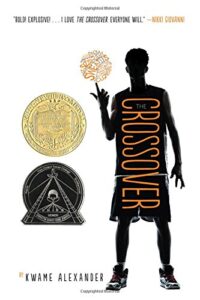Middle School Monday: Classroom Crossover
 We’ve all seen the same books used over and over in some Language Arts classrooms. Many* of them (*most of them) feature white characters and/or are written by white authors.
We’ve all seen the same books used over and over in some Language Arts classrooms. Many* of them (*most of them) feature white characters and/or are written by white authors.
All of the arguments we know and make for authentic representation in books on our shelves are just as important for the books that are used as texts in our classrooms. More important in some ways, because we can help challenge the normative position of whiteness in the curriculum by flooding classrooms with reflective, engaging literature to be used as class texts.
ADVERTISEMENT
ADVERTISEMENT
 The Crossover by Kwame Alexander. Surely, every middle school library in the nation has multiple copies on its shelves. That’s really not enough.
The Crossover by Kwame Alexander. Surely, every middle school library in the nation has multiple copies on its shelves. That’s really not enough.
I see no reason why The Crossover is not being used in Language Arts classrooms in every middle school. It is THAT good. It makes teaching poetry incredibly enjoyable and seamless. Intuitive. There is so much rich, figurative language in The Crossover that it explodes on every page. Similes. Metaphors. Extended metaphors. Alliteration. Personification. All of that beautiful writing makes it an ideal mentor text for students to use to guide and inspire their own poetry.
Plus, it is simply an amazing piece of literature. We pair the novel with the audio, which I highly recommend. Hearing our students verbally respond to the rhymes and rhythms of The Crossover is a highlight of my year.
This is my second year collaborating with our 8th grade ELA teacher to teach the novel, so I’ve read it about nine times. It gets better every time. The novel is so nuanced, the writing so skilled, that I am still seeing new twists and double meanings in each new reading.
Tomorrow, we’ll probably get to page 210. Questions. I cry each time on that page. My students will tease me about it, but I’m comfortable showing them how much I love this work—isn’t that part of our role as librarians? Modeling that love of reading—showing the effect that words can have?
This year, we’re trying out a new choice-based creative project to culminate our learning and discussion with the novel. I’ll let you know how it goes!
Please, please get a class set of this novel and expose your students to the enjoyment of this beautiful piece of literature. We’re planning on doing Booked in the spring. I can’t wait to hear Kwame Alexander himself on that audio!
What are YOUR favorite books to see used in middle school classrooms? How are you chipping away at the literary canon?
Julie Stivers
@BespokeLib
Filed under: Middle School Monday
About Robin Willis
After working in middle school libraries for over 20 years, Robin Willis now works in a public library system in Maryland.
ADVERTISEMENT
ADVERTISEMENT
SLJ Blog Network
Newbery/Caldecott 2025: Spring Check-In
Ellen Myrick Publisher Preview: Spring 2024 – Cicada, Creston, Diamond, and Eye of Newt
Number Call | Review
It’s Time for More Mock Newbery Suggestions
ADVERTISEMENT








Great article! Thank you for drawing attention to the need to break out of the world of white, middle class protagonists and writers. This is my first year at a middle school in a rural, conservative, heavily homogeneous area. My goal for the first 3 years here is to add as many diverse and inclusive titles and writers as possible to begin shifting the student’s paradigms and expanding their worldview.
I love poetry but am not really into sports. My sister was a 3 sport athlete all through school and despises poetry or anything “literary.” We both love THIS book with a fiery passion. I am constantly recommending The Crossover to students and unabashedly gushing over how much I enjoyed it, how much I still think about it. But the kids always try to walk away saying, “I really don’t like poetry…” Don’t give up!
Have a quick conversation about how their idea of poetry (read by an old white man in a snobby, affected voice) is not the way most modern poetry is written. We try to draw correlations to journaling, train of thought, rap and song lyrics. I ask them to read a few of the short pages and ignore the line spacing, just take time to read it like a sentence or a paragraph. They start to get excited. Then flip to the ‘in game’ pages with concrete line placement and the bold, capitalized, stretched and falling words, and they are hooked. At the end I mention some of the content aspects of the story: twins, sick parent, family secrets, basketball, girlfriends… just so they know what they’re getting into.
For me, The Crossover is on the magical pedestal of perfection next to Wonder, The Book Thief, and The Miraculous Journey of Edward Tulane. Nearly every kid I can convince to read it comes back thinking the same. Now, onward to find more diverse voices to celebrate!
Thanks so much for sharing–love your walk through of a Crossover Book Talk!
Great article with an important message.
I loved using The Legend of Tarik by Walter Dean Myers when I taught Middle School literature. It has such a timely well crafted message of characters of different backgrounds unifying against a common enemy. We have so many common “enemies” such as hunger, hatred, disease, and pollution that we can work together to seek to deal with. Unfortunately, this favorite is no longer in print. It needs a reprint!
I’m going to go find a copy! Thanks for the recommendation!